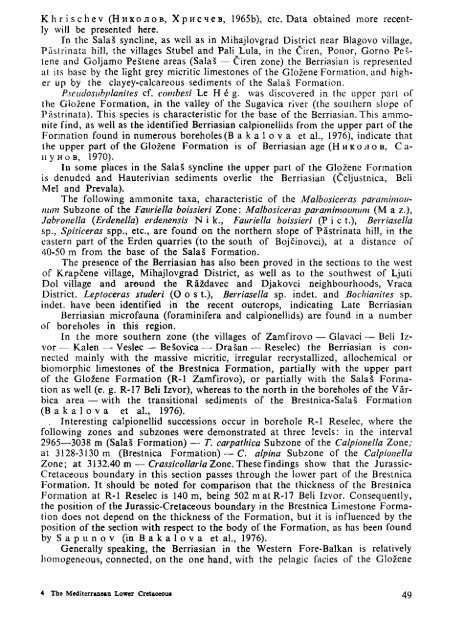THE MEDITERRANEAN LOWER CRETACEOUS
THE MEDITERRANEAN LOWER CRETACEOUS
THE MEDITERRANEAN LOWER CRETACEOUS
Create successful ePaper yourself
Turn your PDF publications into a flip-book with our unique Google optimized e-Paper software.
Khrischev (Николов, Хрисчев, 1965b), etc. Data obtained more recently<br />
will be presented here.<br />
In the Salas syncline, as well as in Mihajlovgrad District near Blagovo village,<br />
Pâstrinata hill, the villages Stubel and Pali Lula, in the Ciren, Ponor, Gorno Pestene<br />
and Goljamo Pestene areas (Salas — Ciren zone) the Berriasian is represented<br />
at its base by the light grey micritic limestones of the Glozene Formation, and higher<br />
up by the clayey-calcareous sediments of the Salas Formation.<br />
Pseudosubplanites cf. combesi Le H é g. was discovered in the upper part of<br />
the Glozene Formation, in the valley of the Sugavica river (the southern slope of<br />
Pâstrinata). This species is characteristic for the base of the Berriasian. This ammonite<br />
find, as well as the identified Berriasian calpionellids from the upper part of the<br />
Formation found in numerous boreholes (B a k a 1 о v a et al., 1976), indicate that<br />
the upper part of the Glozene Formation is of Berriasian age (H и ко л о в, Сапунов,<br />
1970).<br />
In some places in the SalaS syncline the upper part of the Glozene Formation<br />
is denuded and Hauterivian sediments overlie the Berriasian (Celjustnica, Beli<br />
Mel and Prevala).<br />
The following ammonite taxa, characteristic of the Malbosiceras paramimounum<br />
Subzone of the Fauriella boissieri Zone: Malbosiceras paramimounum (M a z.),<br />
Jabronella (Erdenella) erdenensis N i k., Fauriella boissieri (P i с t.), Berriasella<br />
sp., Spiticeras spp., etc., are found on the northern slope of Pâstrinata hill, in the<br />
eastern part of the Erden quarries (to the south of Bojcinovci), at a distance of<br />
40-50 m from the base of the Salas Formation.<br />
The presence of the Berriasian has also been proved in the sections to the west<br />
of Krapcene village, Mihajlovgrad District, as well as to the southwest of Ljuti<br />
Dol village and around the Ràzdavec and Djakovci neighbourhoods, Vraca<br />
District. Leptoceras studeri (О о s t.), Berriasella sp. indet. and Bochianites sp.<br />
indet. have been identified in the recent outcrops, indicating Late Berriasian<br />
Berriasian microfauna (foraminifera and calpionellids) are found in a number<br />
of boreholes in this region.<br />
In the more southern zone (the villages of Zamfirovo — Glavaci — Beli Izvor—Kalen<br />
— Veslec — Besovica—• Drasan — Reselec) the Berriasian is connected<br />
mainly with the massive micritic, irregular recrystallized, allochemical or<br />
biomorphic limestones of the Brestnica Formation, partially with the upper part<br />
of the Glozene Formation (R-l Zamfirovo), or partially with the Sala§ Formation<br />
as well (e. g. R-17 Beli Izvor), whereas to the north in the boreholes of the Vârbica<br />
area — with the transitional sediments of the Brestnica-Salas Formation<br />
(B a k a 1 о v a et al., 1976).<br />
Interesting calpionellid successions occur in borehole R-l Reselec, where the<br />
following zones and subzones were demonstrated at three levels: in the interval<br />
2965—3038 m (Salas Formation) — T. carpathica Subzone of the Calpionella Zone;<br />
at 3128-3130 m (Brestnica Formation) — C. alpina Subzone of the Calpionella<br />
Zone; at 3132.40 m — Crassicollaria Zone. These findings show that the Jurassic-<br />
Cretaceous boundary in this section passes through the lower part of the Brestnica<br />
Formation. It should be noted for comparison that the thickness of the Brestnica<br />
Formation at R-l Reselec is 140 m, being 502 m at R-17 Beli Izvor. Consequently,<br />
the position of the Jurassic-Cretaceous boundary in the Brestnica Limestone Formation<br />
does not depend on the thickness of the Formation, but it is influenced by the<br />
position of the section with respect to the body of the Formation, as has been found<br />
by S a p u n о v (in В a k a 1 о v a et al., 1976).<br />
Generally speaking, the Berriasian in the Western Fore-Balkan is relatively<br />
homogeneous, connected, on the one hand, with the pelagic facies of the Glozene<br />
4 The Mediterranean Lower Cretaceous 49

















